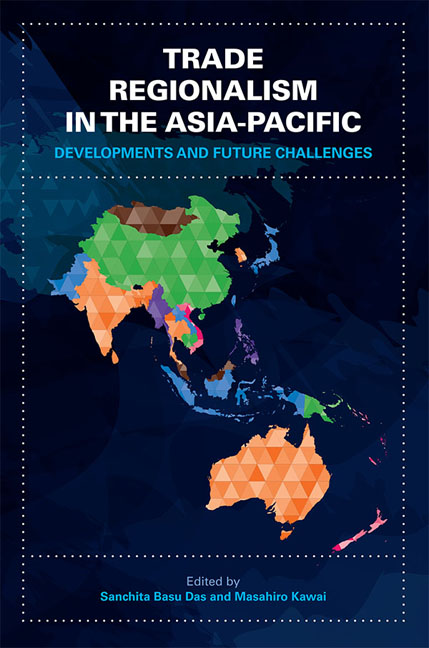Book contents
- Frontmatter
- Contents
- Foreword
- Acknowledgments
- List of Abbreviations
- The Contributors
- 1 Introductory Overview — Trade Regionalism in the Asia-Pacific: Developments and Future Challenges
- I The Trans-Pacific Partnership (TPP) Agreement
- II The Regional Comprehensive Economic Partnership (RCEP) Agreement
- III Regional Economic Integration: A Multi-stage Approach
- IV Old and Emerging Approaches to Asia-Pacific Regional Integration
- V Asia-Pacific Regional Integration: Towards Convergence?
- Index
1 - Introductory Overview — Trade Regionalism in the Asia-Pacific: Developments and Future Challenges
Published online by Cambridge University Press: 05 July 2016
- Frontmatter
- Contents
- Foreword
- Acknowledgments
- List of Abbreviations
- The Contributors
- 1 Introductory Overview — Trade Regionalism in the Asia-Pacific: Developments and Future Challenges
- I The Trans-Pacific Partnership (TPP) Agreement
- II The Regional Comprehensive Economic Partnership (RCEP) Agreement
- III Regional Economic Integration: A Multi-stage Approach
- IV Old and Emerging Approaches to Asia-Pacific Regional Integration
- V Asia-Pacific Regional Integration: Towards Convergence?
- Index
Summary
INTRODUCTION
In the last five years, the mega-regional trade agreements of the Regional Comprehensive Economic Partnership (RCEP) and the Trans-Pacific Partnership (TPP) have caught the fancy of many countries across the Asia-Pacific region. In addition, the Transatlantic Trade and Investment Partnership (TTIP) is also being negotiated and the Pacific Alliance (PA) is being formed, in order to align their participating members with the forces of globalization and hence benefit from the Asia-Pacific's emerging regional agreements.
While the prognosis on these mega-regional deals is unclear at this juncture, it is certain that they will shape the global trade architecture of the twenty-first century — particularly the RCEP and the TPP — because of their sheer size and scope, covering issues that go beyond trade liberalization. However, it has been and will be difficult to first conclude the negotiations and thereafter to implement these mega-regionals as they are bound to face complex challenges. Though the broad text of the TPP has been agreed by the twelve member nations, its full ratification is expected to take sometime. The RCEP process has been slow since the beginning of its journey in May 2013, and missed the deadline of end 2015, as promised earlier.
This overview chapter looks at the literature on Regional Trade Agreements (RTAs), followed by a discussion on the role of RCEP and TPP, covering both economic and strategic aspects, in the bigger geography of the Asia-Pacific region. The chapter, thereafter, provides a short narrative of what is to be expected from the rest of the book. In the final section, it pulls strands from the subsequent chapters to give a flavour of where the future of the global trade environment could be headed.
LITERATURE REVIEW
The post-Cold War proliferation of Free Trade Agreements (FTAs) — a form of new regionalism — has gained prominence as countries struggle to balance the challenge of globalization against domestic interests. The General Agreement on Tariffs and Trade (GATT) received 123 RTA notifications from 1948 to 1994, while the World Trade Organization (WTO) has received notifications for over 300 additional arrangements covering trade in goods and/or services since its inception in 1995.
- Type
- Chapter
- Information
- Trade Regionalism in the Asia-PacificDevelopments and Future Challenges, pp. 1 - 26Publisher: ISEAS–Yusof Ishak InstitutePrint publication year: 2016

